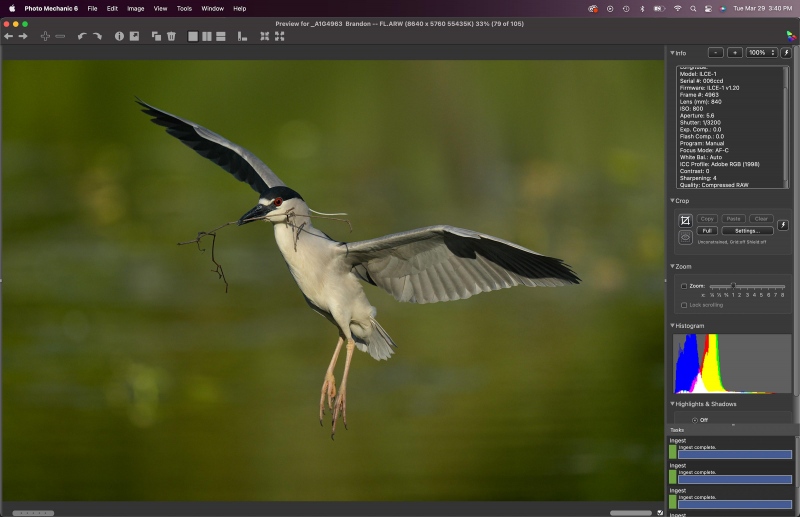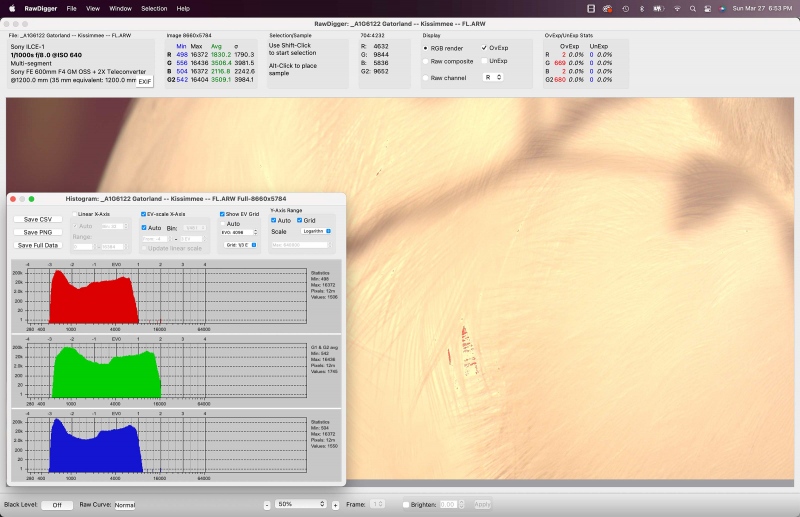What’s Up
Tuesday morning was still and gorgeous on the water in Tampa Bay. I was aboard the Hooptie Deux with Captain James (Froggy) Shadle and four clients: Peter Dominowski, Brendan Burns, Joh Hoiles, and Lorvey Stark. In the pre-dawn, I taught pleasing blur techniques, a new one for all the clients. As the sun rose, we had a great time with bathing Brown Pelicans in golden water. Once the sun up, we got out of the boat only to find that the spoonbills were few and far between. We did have lots of good chances on Brown Pelicans in flight. When the action slacked off a bit we moved to a new location and enjoyed non-stop action with breeding plumage White Ibises in flight. When the light got harsh, I taught the group how to create backlit flight images of the ibises overhead by turning around and facing the sun! All in all, we had a great morning and everyone learned a ton. Peter Dominoskwi had his first flight photography experience with his brand new a1 and was (properly) amazed.
I forgot to check the wind direction before heading back to the wading bird rookery in Brandon at 5:00pm on Tuesday. What little wind there was was from the northeast. With the still conditions few birds were flying. And those that did fly were landing into the wind. I took about 100 images and left. I kept one of a perched Wood Stork …
Today is Wednesday 30 March 2022. The morning forecast for Gibsonton is for partly cloudy with a decent wind from the southeast. I am meeting Froggy and Brenda at the dock at 6:30am. Wherever you are and whatever you are doing, I hope that you too have a great day. This blog post about an hour to prepare and makes twenty days in a row with a new one.
Please remember to use the B&H and Amazon links that are found on most blog pages and to use the BIRDSASART discount code at checkout when purchasing your new gear from Bedfords. Please, also, consider joining a BAA IPT. You will be amazed at how much you will learn …
Unsolicited e-Mail from Jon Hoiles
Thanks again for a wonderful morning at Gatorland. As I said on Sunday, it was an awesome experience for me, not only meeting you, but having the 1:1 time in the field. I was half-expecting to get a few tips and then we’d go shoot, and that would have been good with me. But to get a solid 2.5 hours of hands-on, no-holds-barred photography training time from the best just blew me away. Thank you! I sincerely appreciate how you helped with both the technical aspects of operating the camera (and even the tripod head!) and the creative process of composing an image and using the light to your advantage. And the role of the wind in bird photography! I don’t think I would have gotten the backlit egret with rim-light image if I had been using manual with auto-ISO.
Gatorland In-the-Field Instruction: Saturday April 2 2002, 2 1/2 hours from 7:00 – 9:30am for a ridiculously low $200.00. Limit two photographers.
Please contact me via e-mail to reserve a spot. Payment by cash or check on site is fine.
|
|
|
This image was created on Monday 28 March 2022 at a rookery in Brandon, FL. I used the no-longer-available Induro GIT 304L/Levered-Clamp FlexShooter Pro-mounted Sony FE 600mm f/4 GM OSS lens with the Sony FE 1.4x Teleconverter, and The One, the Sony Alpha 1 Mirrorless Digital Camera.. ISO 800. The exposure for the Cattle Egrets that were flying in was determined by Zebras with ISO on the rear wheel: 1/3200 sec. at f/5.6 (wide open) in Manual mode. RawDigger showed that the image was more than one full stop too dark. AWB at 6:32:59pm on a sunny afternoon. Tracking: Zone AF-C with Bird-Eye/Face Detection performed very well. Click on the image to enjoy the high-res version. Image #1: The Photo Mechanic screen capture for the Black-crowned Night-Heron carrying nesting material image |
The Under-exposed Original
I was getting some great stuff on incoming Cattle Egrets with decent backgrounds when the Black-crowned Nigh-Heron above appeared right in front of me, so close that I could barely fit it in the frame. I had no time to increase the exposure at all much less increase it the 3 clicks that were needed. And not only was the night-heron much darker overall than the Cattle Egrets, but is was slightly shaded as it approached the nest. So I did what I espouse here often: I pressed the shutter button and created a four frame sequence.
I loved the sharpness and the nesting material but I absolutely hated shadow on the left underwing. I spent a half-hour trying to lighten that shadow, but was still not happy. Before you scroll down to Image #1A to see my creative solution, try to figure out what I did.
Cupped Wings Cause Underwing Shadows
Though the night-heron was right on sun angle when I pressed the shutter button, the cupped left wing resulted in the ugly dark shadow under that wing. What to do?
The Lesson
Other than trying to shoot birds in flight right down sun angle, there is nothing that you can do to prevent the dark underwing shadows caused by cupped wings. Because such shadows come and go almost instantly, a 30 frames/second camera body with science-fiction like autofocus is a huge advantage. While editing the pelican and ibis flight shots from, more than 50% of the 2000+ deleted images were the result of unpleasant underwing shadows. Images with evenly lit underwings are highly desired, but are rarer than hen’s teeth.
|
|
|
This image was created on Monday 28 March 2022 at a rookery in Brandon, FL. I used the no-longer-available Induro GIT 304L/Levered-Clamp FlexShooter Pro-mounted Sony FE 600mm f/4 GM OSS lens with the Sony FE 1.4x Teleconverter, and The One, the Sony Alpha 1 Mirrorless Digital Camera.. ISO 800. The exposure for the Cattle Egrets that were flying in was determined by Zebras with ISO on the rear wheel: 1/3200 sec. at f/5.6 (wide open) in Manual mode. RawDigger showed that the image was more than one full stop too dark. AWB at 6:32:59pm on a sunny afternoon. Tracking: Zone AF-C with Bird-Eye/Face Detection performed very well. Click on the image to enjoy the high-res version. Image #1A: The cropped, optimized version of the Black-crowned Night-Heron carrying nesting material image |
The Solution
I hated the dark shadow so much that I simply eliminated it with a vertical crop. As you can see, sharp a1 images can stand up to healthy crops.
I added some canvas on the top and cleaned and softened the background in Photoshop. Details are included in Digital Basics II. Learn the location of the rookery in Brandon in the BAA Middle of Florida Photographic Site Guide. The rookery islands are extremely active this year.
SONY and artie
Switching to SONY, first with the a9 and the a9 II, and then to the remarkable a1, has enabled me (and others, like Mike De Rosa as seen a while ago in the blog post here), to create images of birds in flight and in action that I could not have even dreamed of when using Canon for 33 years and then Nikon for more than two. Right now I am using only two AF methods. that They cover about 99% of the commonly-encountered bird photography situations. Learn more by joining (or by earning your way into) the group!
From Long-ago IPT veteran Keith Kennedy via e-mail
Absolutely great information. I am calling Jim in a few minutes to order a couple of Delkin 128GB UHS-II cards. Your timely email has saved me a ton of money! Many thanks
In the same vein, via e-mail from John LeClair
Well, e-mail #21 alone was worth the price of admission!
From Pamela Viale, after receiving artie’s a1 settings along with detailed instructions on how to copy them to her SONY a1 via e-mail
This e-mail group has been an incredible boon to me! Thank you so much!
From Joe Barranco via e-Mail
Thanks for your great ideas on the A1 set up. I have been getting MANY more keepers doing things your way!
From Barbara White via e-Mail
Wow, I just gotta say – I learn so much from the SONY Alpha a1 Set-up and Info group! My camera is on my desk, and I’m always picking it up and changing something that I’ve read about in the e-mails.
Thanks, Barbara
From Janet Horton via e-Mail
Hi Artie, Mystery solved. Yes, I was able to replicate what you did. I forgot that you have to set self-timer using the upper dial. I am used to that being a MENU selection.
Thanks much, Janet
SONY Alpha a1 Set-up and Info Group
The SONY Alpha a1 Set-up and Info Group is going great guns as more and more folks chime in with thoughtful questions and experience-based answers. As the a1 is becoming more readily available, more and more folks are getting their hands on this amazing body. The group is now up to an astounding 113 lucky and blessed folks. Early on, we discussed the myriad AF options. I gave my opinion as to the best one for flight and general bird photography. The best news is that all who wish, can request an e-mail that includes a .DAT file with my a1 settings on it, and explicit directions on how to load my settings onto your a1; talk about convenience! I am now offering a .DAT file compatible with firmware update 1.20. I finally finished the consolidated Sony a1 CAMSETA2 INFO & GUIDE and distributed it yesterday. New a1 folks will now receive three e-mails instead of the previous 28! It is a lot easier on me and is an incredible resource for folks new to the a1.
All who purchased their Alpha a1 bodies via a BAA affiliate link will receive a free subscription to the Sony Alpha a1 Set-Up and Info Updates group after shooting me their receipts via e-mail. (Note: it may take me several days to confirm B&H orders.) This same service may be purchased by anyone with an a1 body via a $150.00 PayPal sent to birdsasart@verizon.net indicating payment for Alpha a1 Info & Updates. Alternatively, folks can call Jim weekdays at 1-863-692-0906 to pay via credit card. New members will receive composite e-mails that summarize all previous discussions.
Typos
With all blog posts, feel free to e-mail or to leave a comment regarding any typos or errors.
























